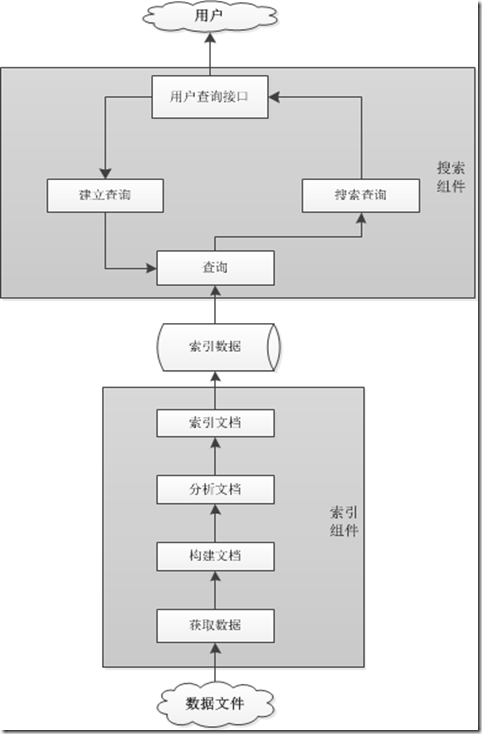Luence初探
一直觉得全文索引是个很神密的东西,所以很想一探究竟。查阅了网上的资料,做个整理。(以下内容均来自互联网)
一、全文索引
定义一系列词条,用这些词条在要搜索的文件匹配,记录下匹配到地址,将这些词条与匹配地址记录下来,形成索引。当查询词条时,可以直接从索引中读取到目标的位置而实现的快速索引。
MS Sql中也提供了全文索引服务,关于MS Sql的全文索引可以参看MSDN。相比Luence的使用,MS Sql的全文索引要简单的多。
二、什么是Luence
Luence是一个开源搜索引擎构架,最初为java版本,现.net,C++,Pascal等语言都有相应的版本。个人将Luence分为索引组件和搜索组件。一个完整的搜索引擎要由以下几个部分组成:
1.检索原始内容;
2.根据原始内容来创建对就的文档,如从二进制文件中提取文本信息;
3.创建文档
4.分析文档
5.对文档进行索引,建议索引文件
6.提供可编程查询语句和用户查询接口
7.展现查询结果
获取数据:
检索的数据是多样的,可能是txt文件,也可能是word,pdf等文档,索引前需要提取数据为可识别的数据(通常为纯文本),Luence不提供这部分功能,具体的获取方法由搜索程序自己定义,也可以用现有的第三方具,如蜘蛛/蚂蚁等
构建文档:
获取数据之后要形成通常意义上的“文档”,一个文档通常包括:文件名,标题,内容。
分析文档:
有了文档前不是就可以检索,还要将文档拆分成可搜索的格式,通常要用到分词技术,另外还要去除一些无用字符,如:如果是html文件,则需要将html标签去除。文档分析结果通常是一个字词与文档的对应记录
索引文档:
文档经过分析后,就可以将文档的分析结果存入索引数据库了。索引数据库是一个经过精心设计的数据库结构。它将关键字/词与文档及文档中的字词位置成一个键值对存储起来
查询:
有了索引数据后,使用查询组件对数据进行查询了。查询也有很多种策略,如:纯bool匹配,向量空间模型,相似度匹配等。
三、Luence使用示例
以下Demo演示对目录下.txt文件进行索引并查询
using System; using System.Collections.Generic; using System.Text; using System.IO; using Lucene.Net; using Lucene.Net.Analysis; using Lucene.Net.Analysis.Standard; using Lucene.Net.Documents; using Lucene.Net.Index; using Lucene.Net.QueryParsers; using Lucene.Net.Search; using Lucene.Net.Store; using Lucene.Net.Util; namespace LuceneNet { public class LuceneIndex { private const string FieldName = "industry"; private const string FieldValue = "value"; private string indexDir = @"D:\temp\"; //Luence的索引存储目录 private string dataDir = @"D:\temp\"; //要被索引的文件目录 private IndexWriter indexWriter; public LuceneIndex() { DirectoryInfo dirInfo = new DirectoryInfo(indexDir); Lucene.Net.Store.Directory dir = FSDirectory.Open(dirInfo); Analyzer analyzer = new StandardAnalyzer(Lucene.Net.Util.Version.LUCENE_29); indexWriter = new IndexWriter(dir, analyzer, true ,IndexWriter.MaxFieldLength.UNLIMITED ); } public void Index() { string[] files = System.IO.Directory.GetFiles(dataDir,"*.txt"); //只索引目录下的.txt文件 foreach (string fileFullPath in files) { Document doc = new Document(); using (StreamReader sr = new StreamReader(fileFullPath)) { StringReader stringReader = new StringReader(sr.ReadToEnd()); //读取整个文件,将被转为StringReader对象 Fieldable field = new Field("Content", stringReader); //分析文档内容并将其添加到Content域中 doc.Add(field); //记录文档的全路径
Fieldable fieldPath = new Field("FullPath", fileFullPath, Field.Store.YES, Field.Index.NOT_ANALYZED); doc.Add(fieldPath); indexWriter.AddDocument(doc); //添加到索引 } } indexWriter.Close(); } } }
new Field("Content", stringReader); 构造函数用于分析体积较大的文件。Fieldable field = new Field("Content", stringReader); //分析文档内容并将其添加到Content域中 doc.Add(field);
Fieldable fieldPath = new Field("FullPath", fileFullPath, Field.Store.YES, Field.Index.NOT_ANALYZED);
doc.Add(fieldPath);
new Field("FullPath", fileFullPath, Field.Store.YES, Field.Index.NOT_ANALYZED);构造函数用于保存文件的完整路径。
Field.Store.YES--保存到索引
Field.Index.NOT_ANALYZED--不对内容做分析,保持原始内容
Luence搜索文件
查询时要用 Query q = parser.Parse(s);将查询关键词转为IndexSearcher可识别的Query对象
最后在main函数中测试
using System; using System.Collections.Generic; using System.Text; namespace LuceneNet { public class Program { static void Main(string[] args) { LuceneIndex test = new LuceneIndex(); test.Index(); LuceneSearch search = new LuceneSearch(); search.Query("abcdefg"); } } }
比如txt文件中存在以下内空:
abcdefg中国工产abcdefg
搜索abcdefg可以正确返回结果,并输出文件的全路径,搜索abcd不会返回结果,说明Luence是根据中英文分词的。
但搜索”中国共产”也不会有返回结果,中文分词搜索需要使用中文词库。后面看到怎么做时再写出来
曾经年少多少事 而今皆付谈笑中!





 浙公网安备 33010602011771号
浙公网安备 33010602011771号